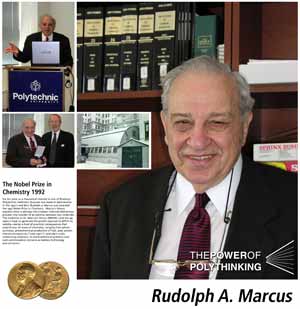
For his work as a theoretical chemist in one of Brooklyn Polytechnic Institute's Quonset hut research laboratories in the 1950's and 60's, Rudolph A. Marcus was awarded the 1992 Nobel Prize in Chemistry. Marcus's theory explains what is perhaps the simplest chemical elementary process — the transfer of an electron between two molecules. The simplicity of Dr. Marcus's theory (RRKM) — and the 40 years it took to generate the proofs required to affirm its validity — belies a host of practical consequences that extend over all areas of chemistry, ranging from photo-synthesis, photochemical production of fuel, solar power, chemiluminescence ("cold light") and electrically conducting polymers, to electrochemical synthesis and such commonplace concerns as battery technology and corrosion.